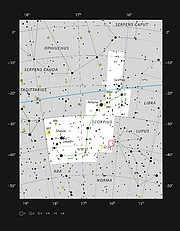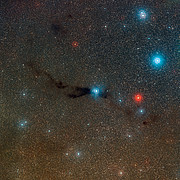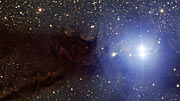Press Release
Light from the Darkness
16 January 2013
An evocative new image from ESO shows a dark cloud where new stars are forming, along with a cluster of brilliant stars that have already emerged from their dusty stellar nursery. The new picture was taken with the MPG/ESO 2.2-metre telescope at the La Silla Observatory in Chile and is the best image ever taken in visible light of this little-known object.
On the left of this new image there is a dark column resembling a cloud of smoke. To the right shines a small group of brilliant stars. At first glance these two features could not be more different, but they are in fact closely linked. The cloud contains huge amounts of cool cosmic dust and is a nursery where new stars are being born. It is likely that the Sun formed in a similar star formation region more than four billion years ago.
This cloud is known as Lupus 3 and it lies about 600 light-years from Earth in the constellation of Scorpius (The Scorpion). The section shown here is about five light-years across.
As the denser parts of such clouds contract under the effects of gravity they heat up and start to shine. At first this radiation is blocked by the dusty clouds and can only be seen by telescopes observing at longer wavelengths than visible light, such as the infrared. But as the stars get hotter and brighter their intense radiation and stellar winds gradually clear the clouds around them until they emerge in all their glory.
The bright stars right of the centre of this new picture form a perfect example of a small group of such hot young stars. Some of their brilliant blue light is being scattered off the remaining dust around them. The two brightest stars are bright enough to be seen easily with a small telescope or binoculars. They are young stars that have not yet started to shine by nuclear fusion in their cores and are still surrounded by glowing gas [1]. They are probably less than one million years old.
Although they are less obvious at first glance than the bright blue stars, surveys have found many other very young stellar objects in this region, which is one of the closest such stellar nurseries to the Sun.
Star formation regions can be huge, such as the Tarantula Nebula (eso0650) where hundreds of massive stars are being formed. However, most of the stars in our and other galaxies are thought to have formed in much more modest regions like the one shown here, where only two bright stars are visible and no very heavy stars are formed. For this reason, the Lupus 3 region is both fascinating for astronomers and a beautiful illustration of the early stages of the life of stars.
Notes
[1] These are known as Herbig Ae/Be stars after the astronomer who first identified them. The A and B refer to the spectral types of the stars, somewhat hotter than the Sun, and the “e” indicates that emission lines are present in their spectra, due to the glow from the gas around them. They shine by converting gravitational potential energy into heat as they contract.
More information
ESO is the foremost intergovernmental astronomy organisation in Europe and the world’s most productive ground-based astronomical observatory by far. It is supported by 15 countries: Austria, Belgium, Brazil, Czechia, Denmark, France, Finland, Germany, Italy, the Netherlands, Portugal, Spain, Sweden, Switzerland and the United Kingdom. ESO carries out an ambitious programme focused on the design, construction and operation of powerful ground-based observing facilities enabling astronomers to make important scientific discoveries. ESO also plays a leading role in promoting and organising cooperation in astronomical research. ESO operates three unique world-class observing sites in Chile: La Silla, Paranal and Chajnantor. At Paranal, ESO operates the Very Large Telescope, the world’s most advanced visible-light astronomical observatory and two survey telescopes. VISTA works in the infrared and is the world’s largest survey telescope and the VLT Survey Telescope is the largest telescope designed to exclusively survey the skies in visible light. ESO is the European partner of a revolutionary astronomical telescope ALMA, the largest astronomical project in existence. ESO is currently planning the 39-metre European Extremely Large optical/near-infrared Telescope, the E-ELT, which will become “the world’s biggest eye on the sky”.
Links
- Research review paper
- Photos of the MPG/ESO 2.2-metre telescope
- Other photos taken with the MPG/ESO 2.2-metre telescope
- Photos of La Silla
Contacts
Fernando Comeron
ESO
Garching bei München, Germany
Email: fcomeron@eso.org
Richard Hook
ESO, La Silla, Paranal, E-ELT and Survey Telescopes Public Information Officer
Garching bei München, Germany
Tel: +49 89 3200 6655
Cell: +49 151 1537 3591
Email: rhook@eso.org
About the Release
| Release No.: | eso1303 |
| Name: | Lupus 3 |
| Type: | Milky Way : Nebula : Appearance : Dark |
| Facility: | MPG/ESO 2.2-metre telescope |
| Instruments: | WFI |






